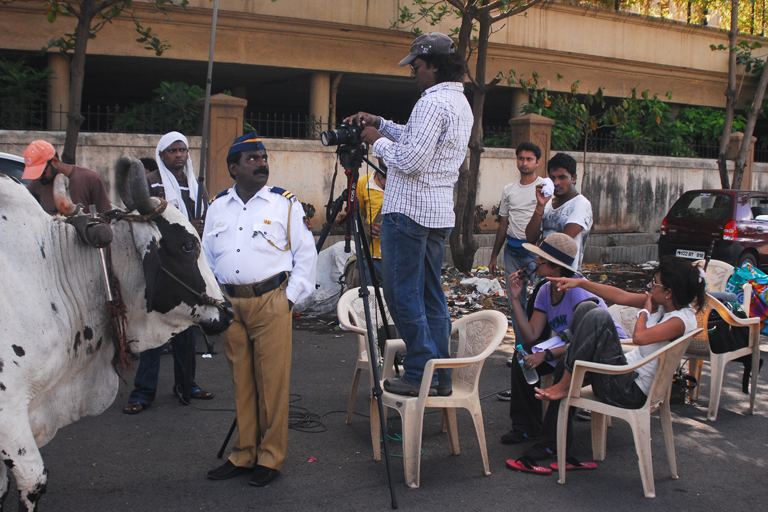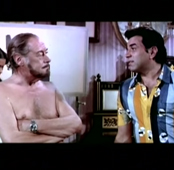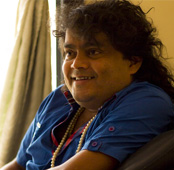-
 A local kid contributes to the People-Powered Script-less Video Art Project
A local kid contributes to the People-Powered Script-less Video Art Project -
 A poster in Hindi and English invites bystanders to take part in the People-Powered Script-less Video Art Project
A poster in Hindi and English invites bystanders to take part in the People-Powered Script-less Video Art Project -
 Shooting for the People-Powered Script-less Video Art Project
Shooting for the People-Powered Script-less Video Art Project -
 Shooting for the People-Powered Script-less Video Art Project
Shooting for the People-Powered Script-less Video Art Project -
 A passer-by contributes to the People-Powered Script-less Video Art Project
A passer-by contributes to the People-Powered Script-less Video Art Project -
 Filming on set in Berlin for The Owner
Filming on set in Berlin for The Owner -
 On location with the Bogota crew of The Owner
On location with the Bogota crew of The Owner -
 Filming on set in Dubai for The Owner
Filming on set in Dubai for The Owner -
 Filming on the streets in Dublin for The Owner
Filming on the streets in Dublin for The Owner -
 The London crew of The Owner
The London crew of The Owner -
 On location with the Mumbai crew of The Owner
On location with the Mumbai crew of The Owner -
 On location with the New York crew of The Owner
On location with the New York crew of The Owner -
 Filming on the streets in Paris for The Owner
Filming on the streets in Paris for The Owner -
 On set with the Vienna crew of The Owner
On set with the Vienna crew of The Owner -
 On the sets of The Last Act
On the sets of The Last Act -
 On the sets of The Last Act
On the sets of The Last Act
TBIP reports on a new experiment in filmmaking that is catching on
On November 4, 2012, a Sunday morning, Dr. Parvez Imam walked into Devi Art Foundation, in Gurgaon, for the first shoot of his collaborative video art project, to find that none of whom he had invited to participate in it had turned up. So he started shooting instead with the guards at the foundation, the manager of its cafeteria, and other staff who happened to be there. As the shoot progressed, Imam noticed that those who had finished playing their part were engaged in a heated discussion on how the film should play out. They were saying: “Nahin, galat kar di story (No, we took the story the wrong way). Idhar nahi, udhar honi chahiye thi. Arrey isne to aise kar diya, aise thodi jayegi story (It shouldn’t have gone here, it should have gone there. Now he’s made the story like this, but it isn’t how it’ll work)”. Imam, 45, a psychiatrist turned filmmaker, is fascinated by how, in the middle of his experiment, “the artists were becoming their own critics”. This is one of the things the People-Powered, Script-less Video Art Project tries to build on.
Imam’s film, supported by Sarai—a program of the Centre for the Study of Developing Societies (CSDS)—one of Delhi’s most reputed research institutes, is still being shot. It is one of three intriguing film collaborations that have emerged on the Indian cinematic horizon last year. The other two, which were completed and released in 2012, are The Owner, a collaboration between 25 directors (of which four were Indian) from 14 countries, and The Last Act, a whodunit made by 12 filmmakers from India.
“The basis of my project,” says Imam. “Is understanding how we can take filmmaking, which is thought of as such an elite thing, to literally anybody who wants to participate”. He shoots on the streets in Delhi and Gurgaon. He puts up a banner that says “Jan Sanchalith Video Film” in English and in Hindi and waits for people to come. Imam gave the film its first byte, starting it off with why he’s making it. Other initial scenes show the guards and staff at Devi Art Foundation weaving a story about a girl auditioning for a role and attending a film shoot. But the ‘story’ could go anywhere. Anyone can walk up and ask to be a part of the film, and become its narrator. Anyone from a lay child, who had said: “Main bhi karta hoon (I’ll do this as well)”, to a temple priest, a milkman from Faridabad, an auto-rickshaw driver or a security guard who was insistent on reciting a poem he remembered being taught in his village school. When people ask Imam for his opinion to see if their contribution fits in with the rest of the story, Imam consciously refrains from influencing ‘their’ film. “The politics of aesthetics (of movies today) is also that they come from the director and the director comes from a certain background,” he says. “So I’m also trying to let that be, so that it’s their aesthetics, their way of storytelling.”
***
The Owner was released on May 25, 2012. It was steered by Collabfeature, an international co-production film group founded by filmmakers Marty Shea, 35, and Ian Bonner, 34, in 2008, and run out of Shea’s tiny apartment in Detroit. The Owner is their first film. It chronicles the journey of a backpack as it is passed from person to person through 14 countries. People put things into it, and take items out too. Of the people who come across the backpack, some want to own it for various reasons, some try to deduce who its owner might be from the contents so they can send it back.
“I first had the idea back in college, where I was studying ‘auteur’ filmmakers who have a strong personal vision,” says Shea. “But I was also interested in music and I love the idea of each musician responding to the other, each contributing their own personality and vision to the song, so that the result is bigger than the sum of its parts.” How one musician got a melody and then the other improvised a beat and then another added the lyrics and a song was born. That got him thinking about how the concept of a band could apply to filmmaking: “How Ethan Coen would sit at the typewriter while Joel Coen paced around and how you can start to see their two distinct personalities in different scenes. The way Mike Leigh writes his films through improvising with his actors.” Shea says he felt like “anthology films had always existed”, but he “never saw one where I felt like there was real collaboration”.
Well known films such as Paris, je t’aime and New York, I Love You have brought together several directors to work on one film before. Yet each of these has been, in the end, a collection of distinct short film segments, not a feature length movie with a continuous narrative, a connected story.
Shea and Bonner began collabfeature.com as a one page website with a message board. They mailed other filmmakers and posted the link to their site on filmmaker forums. But after one enthusiastic response from a filmmaker, the emails were not replied to for days on end. “I remember thinking that the interest just wasn’t there,” says Shea. “Then slowly, people started joining the message board and the excitement started to build.” They didn’t know what their first film would be. “We just wanted to start a conversation about collaborative filmmaking,” Shea says. “Then we came up with the ‘backpack project’ in 2010 and invited the filmmakers to participate and to shoot on a no to low budget.” The Owner was a name the filmmakers chose for the film the ‘backpack project’ became— by consensus.
Two years later, collabfeature.com is powered by a web application—that Bonner built and is looking to patent—which allows registered filmmakers to interact with each other, provide feedback, vote and upload scripts and film footage. For The Owner filmmakers submitted a portfolio with their application to be a part of the collaboration, and, says Shea, “every applicant was reviewed by the already accepted filmmakers, making even the acceptance of new members a collaborative process.”
Beginning with the premise of a backpack that travels around the world, the filmmakers brainstormed ideas for their own segment of the film, ranging from four to five minutes, shot in their own countries. Finally they came up with an outline of a story that included all of the film segments. “A lot of it was dictated by geography,” says Shea. “European segments had to connect to each other, US cities and Indian cities had to also connect.” Everyone spoke English and all scripts and pitches were done in English, but ultimately every filmmaker shot their part of the film in their local language.
Every filmmaker fixed the budget for and funded their segments for The Owner themselves, without any official investor or financial partner. Only common and centralized expenses, such as those involving shipping the bag to different countries, hard drives, internet related and legal expenses, were covered by the project directors, Shea and Bonner. A point system was instituted to mark the participation of each collaborator and determine his or her final share in the film’s profits. John Versical, one of the filmmakers involved, says: “the points acted as an incentive to stay as involved as possible, even if it meant just logging into the discussion board a few times a week and providing feedback.”
Shea remarks that, through collabfeature.com’s centralized web application, he has “gotten to know many of my collaborators so well even though we haven’t met in person.”
Neha Raheja Thakker, 32, a Mumbai based architect turned filmmaker, was one of the Indians shooting a segment for The Owner. She says what was most exciting for her was the feedback she got at every stage of the process, on “the writing, the rough cuts, the sound… you always had this group to turn to”. “They wanted to make your product as good as their product,” she says. “It wasn’t about competing, it was about collaborating”.
However, she admits “a lot of disagreements came up at the rough cut stage and also because the duration of the project has been fairly long”. This led to some filmmakers dropping out of the project.
Asmit Pathare, 29, another Indian filmmaker shooting a segment for The Owner was disappointed because “It took almost 12 months for me to make my five minute segment. When I finally saw the output only 20 seconds of my segment was there”.
Pathare met filmmaker Anurag Kashyap while promoting The Owner and spoke to him about the film. “He was really excited,” says Pathare. “I think that thought stuck with Anurag. Even after that when I met him a couple of times at his place, he did mention that film to me.” Later in the year, Show House India, an event management company, put together The Last Act, produced by their subsidiary Show House Films. This was put together under an initiative called Large Short Films, funded by Show House India’s client Royal Stag Mega Movies, a brand that is subsidiary to the alcohol brand Royal Stag. Filmmakers Kashyap, Sudhir Mishra and Chakri Toleti were asked to mentor the project. Kashyap provided a plot outline for a murder mystery: a mangled dead body was to be found with 12 clues on it from 12 different cities. Each segment in each city would be filmed by a different director, making this a collaboration between 12 filmmakers. It was decided that the film would be premiered on December 12, 2012.
Kashyap also asked Pathare to direct one of the segments and to be Project Director for the entire film. Unlike in The Owner, however, here Pathare was the only point of contact for the other 11 directors, who had to sign a contract to not communicate with each other while they made their parts of the movie. Every step in the pre-production, shoots and post-production was co-ordinated by Pathare through individual phone calls to each director. When asked why the directors were prevented from talking to one another, Pathare says: “We needed to put that extra layer of challenge so that it would make it difficult for the filmmakers to make the film. If they still made the film, then that would be a big achievement.” Whether or not that makes much sense, the removal of the need for consensus every step of the way, while not aligning with an ideal vision of a collaboration, does seem to have sped things up. Unlike The Owner, which almost took two years to make, The Last Act was completed in about five months. It was launched, as planned, on ‘12.12.12’.
***
Any film is a collaborative venture. A large team of individuals work together to make a movie. And yet every film usually has one director, the proverbial captain of the ship, who steers the entire project to its final destination. So what happens when there are not one, but several directors? Both of the completed collaborations, The Owner and The Last Act play on this idea of quest. The premise of each movie was thought of so as to complement its form.
Yet a differing degree of control in each of these collaborations has affected the final film. In The Owner the filmmakers started with nothing but the idea of a backpack traversing the length and breadth of the world in search of its owner. This inanimate object is the only constant that is used to channel the viewer’s attention as he or she traverses through 25 segments, spread out over 14 countries. The backpack becomes an object to be coveted, an object of discord, of curiosity, evoking a variety of responses as it changes hands. The charm of The Owner lies in its motley mix of genres, styles and secondary characters. Every bit of the film showcases the style of a particular director and takes you on a whirlwind trip not only across the world, but also across cinematic sensibilities. As we follow the backpack’s journey in search of its owner, we realize that there might, in fact, not be such a person at all. The backpack becomes a metaphor for the movie, a receptacle for the ideas and experiments of different directors. The minor moments of dissonance cease to matter. The fast moving segments become a cinematic style in themselves.
In the case of The Last Act, the genre of the film was predetermined. This narrowed the range of directions it could go in. So, despite not being allowed to discuss their scripts with one another, 10 out of the 12 filmmakers ended up writing their segment around murder investigations conducted by the respective city’s police force, as opposed to those conducted by private detective agencies, or merely bystanders, perhaps, who could have gotten embroiled with the case somehow. Each of these were possibilities, even within the crime genre, which went untapped mostly. Yet, this could also perhaps be the reason why there is a stronger sense of uniformity and cohesion in the story lines and the style of the film’s 12 segments. Despite not having a central character the mystery is seen as unfolding through the eyes of the investigator in each city. To the credit of this collaboration, the detailing of the plot in each city is incredible, though this does also make it difficult to keep up with the film because of the number of things you need to remember as you go along. The final segment goes a long way in bringing the film together.
In sharp contrast, the style, content and form of the more fluid and freewheeling People-Powered, Script-less Video Art Project depends entirely on the frequently changing narrator of the story, the person speaking to the camera. Imam’s project may be smaller in scale, but it strives to go a step further than the other two by allowing for unpredictable and unique results from its collaborations, possibly because these collaborations are with amateurs, rather than professionals who have set ways of thinking about cinema. Each collaborator’s ideas, language and gestures are reflective of the part he or she plays in society. The camera remains a still spectator and this sharpens the focus on the narrator. Imam keeps coming back to talking about the awe and exclusivity commonly associated with the camera, which distances it from the natural. “Filmmaking is considered this huge exercise, some scary kind of thing which doesn’t happen anywhere and everywhere,” he says. “So the idea is to reverse and re-inverse all of that.”
All Together Now
ArticleJanuary 2013
 By Meryl Mary Sebastian
By Meryl Mary Sebastian
Meryl Mary Sebastian is Trainee Correspondent at The Big Indian Picture













